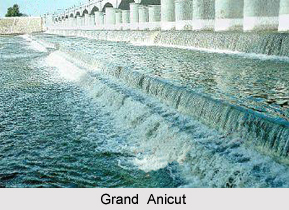 The Grand Anicut, built on the Kaveri River is located in the Indian state of Tamil Nadu. It is an ancient dam also known as Kallanai and is situated almost 20 KM from Tiruchirapalli. The dam was constructed by the Chola king Karikalan during the 2nd Century AD. It is thus, regarded as one of the oldest water diversion structures in the world that is presently used. The Grand Anicut represents Dravidan Engineering.
The Grand Anicut, built on the Kaveri River is located in the Indian state of Tamil Nadu. It is an ancient dam also known as Kallanai and is situated almost 20 KM from Tiruchirapalli. The dam was constructed by the Chola king Karikalan during the 2nd Century AD. It is thus, regarded as one of the oldest water diversion structures in the world that is presently used. The Grand Anicut represents Dravidan Engineering.
Geography of Grand Anicut
The Kaveri River acts as a boundary between the Erode and Salem districts. The river is joined by the Bhavani River in the town of Bhavani. At the confluence of these two rivers the famous Sangameswarar Temple has been constructed. This is a famous pilgrimage centre here. After flowing forth it then divides into two channels at the island of Srirangam. The northern channel is known as Kollidam (Kolidam); the other one is known as Kaveri. It then flows into the Bay of Bengal at Poompuhar located a hundred miles south of Chennai.
The Grand Anicut has been built to redirect the waters of Kaveri River into the fertile delta region for irrigation purpose. The waters are directed into the fields through canals. The dam then divides the Kaveri River into 4 streams. These are known as Kollidam Aru, Kaviri, Vennaru and Puthu Aru. The construction technique of the dam stands as an example for many engineers that included Sir Arthur Cotton`s 19th century dam. It had been constructed across the Kollidam that forms a major tributary of the Kaveri. The dam provides water to one million acres.
This article is a stub. You can enrich by adding more information to it. Send your Write Up to content@indianetzone.com



















